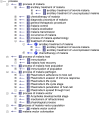IDOMAL: an ontology for malaria
- PMID: 20698959
- PMCID: PMC2925367
- DOI: 10.1186/1475-2875-9-230
IDOMAL: an ontology for malaria
Abstract
Background: Ontologies are rapidly becoming a necessity for the design of efficient information technology tools, especially databases, because they permit the organization of stored data using logical rules and defined terms that are understood by both humans and machines. This has as consequence both an enhanced usage and interoperability of databases and related resources. It is hoped that IDOMAL, the ontology of malaria will prove a valuable instrument when implemented in both malaria research and control measures.
Methods: The OBOEdit2 software was used for the construction of the ontology. IDOMAL is based on the Basic Formal Ontology (BFO) and follows the rules set by the OBO Foundry consortium.
Results: The first version of the malaria ontology covers both clinical and epidemiological aspects of the disease, as well as disease and vector biology. IDOMAL is meant to later become the nucleation site for a much larger ontology of vector borne diseases, which will itself be an extension of a large ontology of infectious diseases (IDO). The latter is currently being developed in the frame of a large international collaborative effort.
Conclusions: IDOMAL, already freely available in its first version, will form part of a suite of ontologies that will be used to drive IT tools and databases specifically constructed to help control malaria and, later, other vector-borne diseases. This suite already consists of the ontology described here as well as the one on insecticide resistance that has been available for some time. Additional components are being developed and introduced into IDOMAL.
Figures



References
Publication types
MeSH terms
LinkOut - more resources
Full Text Sources
Medical
Research Materials

